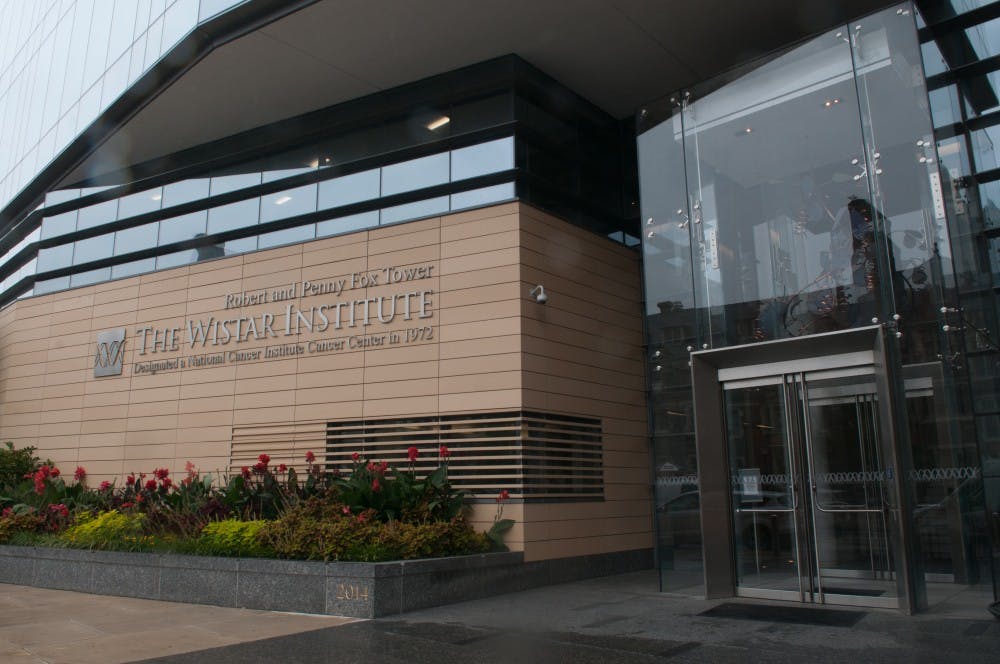Situated across from the Quad and easily mistaken for another Penn academic building with its large archways and yellow brick exterior, The Wistar Institute, an independent biomedical research institute, is celebrating its 125th anniversary this year with a range of events.
In anticipation of its anniversary, Wistar has hosted events for its new Women and Science series including the presentation of the Helen Dean King Award to Nancy H. Hopkins, a biology professor Emerita at the Massachusetts Institute of Technology, who not only contributed to various important scientific discoveries, but also has confronted gender inequity in science throughout her career.
The Wistar Institute was founded by Isaac Wistar in honor of his great uncle Caspar Wistar, a prominent Philadelphia physician and professor of anatomy and surgery at Penn. The Institute was originally created in order to preserve a museum containing Caspar's collection of medical models and human specimens.
According to Wistar's President and Chief Executive Officer Dario Altieri, ongoing research at the institute focuses on two main areas: "immunology, virology and vaccines" and cancer research.
He said Wistar has recently made an effort to focus their research in these two areas partly to promote collaboration.
“It was difficult for the scientists to collaborate because everyone was doing something different,” Altieri said.
Wistar researchers have been responsible for many of the major advances in vaccine development throughout American history.

RELATED:
What students in the energy research program VIPER think about its heavy requirements
Climate change research at Penn might take a nosedive under Trump's new budget
In 1969, Wistar researcher Stanely Plotkin, now a Penn emeritus professor of pediatrics, developed a live vaccine to prevent Rubella, commonly known as German measles, which causes mild symptoms in adults, but can produce severe birth defects, or even death, in developing babies. In 2004, the Centers for Disease Control and Prevention declared rubella to be eliminated in the United States due in large part to the Plotkin's vaccine program.
In the 1980s Wistar's Director of Academic Affairs William Wunner developed the first oral vaccine to prevent rabies in animals.
“To this day, Wistar enjoys royalty payments from licensing agreements with different pharmaceutical industries for vaccines that were made,” Altieri said.
Other historical scientific achievements of the Institute include breeding the Wistar rat, a type of albino rat, the first standardized lab animal. More than half of present day laboratory rats are descendants of the Wistar rat.
Aside from conducting scientific studies, Wistar also collaborates with Penn on educational efforts. Penn graduate students from the Biomedical Graduate Studies, Biology or Chemistry graduate groups are invited to complete their doctoral research in labs at Wistar.
Some Wistar faculty also teach Penn courses, such as Wistar Vice President and Penn Professor Emeritus David Weiner who is teaching the graduate-level CAMB 609 Vaccines and Immunization Therapy course this semester.
While Wistar prides itself on being a non-profit, independent research institution, Altieri said the spirit of collaboration is a large part of the Wistar culture. Over two-thirds of papers published at Wistar are in collaboration with other labs around the world, and over one-third are published with collaboration between other labs at Wistar.
The ability to collaborate easily with Penn due to Wistar’s location has been a crucial factor in Wistar’s success, according to Altieri.
“It’s been a very important aspect of how the institute has grown. We have a lot of collaborations with Penn faculty, Penn departments, [and] joint grants,” Altieri added.
Professor and Program Leader in the Translational Tumor Immunology Program Dmitry Gabrilovich said that he believes Wistar stands out as a research institute because of its small size, highly collaborative atmosphere and the latest technologies that are housed inside the institute.
“[These aspects] really promote research in much faster speed than in many other places,” Gabrilovich said.



